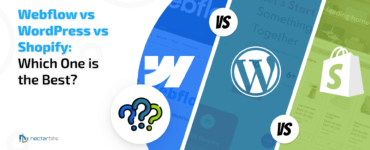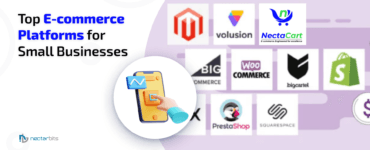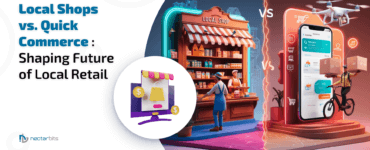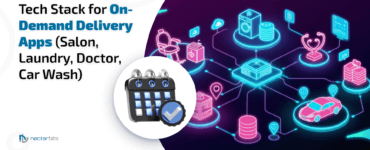In the 21st century, E-commerce is the most lucrative business with the growing instant gratification needs of the people. The leading players such as Amazon, Walmart, eBay, and Alibaba have made millions of dollars with the online retailing concept.
It encourages the novices to try their hands in the E-commerce space, flourish the business endlessly, and earn huge ROI with a great reputation in the market. But, everything is not so rosy.
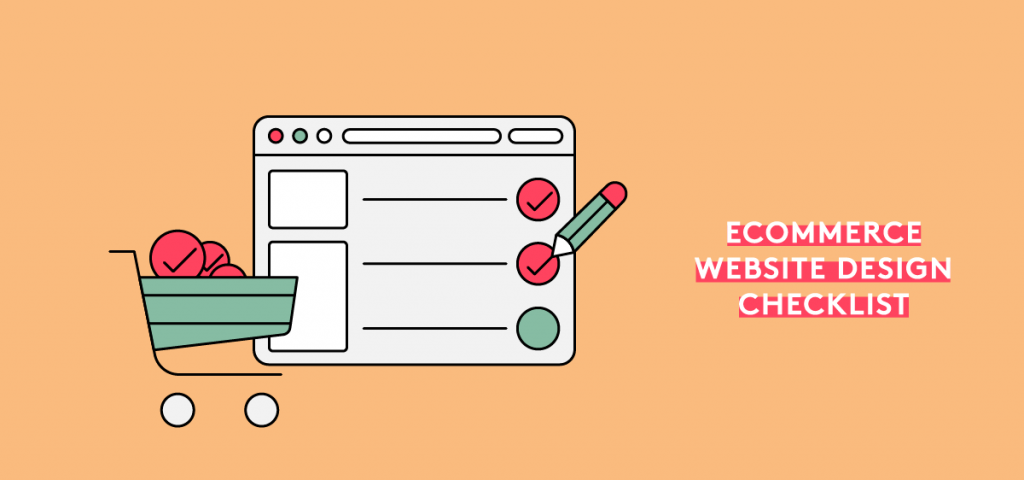
With plenty of options, the budding entrepreneurs face challenges, confusion, and roadblocks when they get into Ecommerce web store development. Remember, choosing the right product to sell, figuring out the customer base, establishing a connection with customers, market and competition research, and pricing structure lay the foundation of the website, but all effort goes into vain if the website is not built right.
Read more: Benefits of E-Commerce
Despite having technical skills, the entrepreneurs remain confused about where to start, how to start, and what to finish with. Recognizing the core concerns, our business consultants have created a comprehensive guide that enlists 10 steps to follow for building a full-fledged eCommerce solution.
Let’s dive in!
Find the website builder that fits your needs
There are many online platforms available that allow the new players to build and launch the business website with effortless management of the website, sales, marketing, and other operations. With low-cost entry, little-to-no technical headaches, and scalability features, the businesses can be streamlined while interacting with the clients, customers, and employees.
All in all, the platforms are the strong backbone of the eCommerce businesses that helps them compete online otherwise, building the platform in-house is a laborious and expensive affair and unscalable and difficult to manipulate too.
In this process, the eCommerce platform is the best fit for your website, but finding the one that meets your business-specific requirements cannot be based on popularity. Instead, the platform that helps you in achieving objectives and delivering the outcomes is the right choice. Find the one which works best for you:

Shopify: It’s packed with many plugins, themes, and in-built tutorials, which makes it easier for the non-tech guy to start with. If you are low on technical knowledge and want to develop scalable e-commerce, Shopify is an ideal choice. Also, with Facebook, Amazon, and other types of integrations, the products can be marketed and sold on multiple channels.
WooCommerce: The platform gains an upper hand with a comparatively large number of plugins and robust features that enable a high degree of customizations. But, meeting the coding requirements during customization requires a heavy dose of technical capabilities.
BigCommerce: As on-premise technologies falling behind, open SaaS platforms like- BigCommerce is taking a big leap forward with continuous updates, robust security, reliable hosting, PCI compliance, and SEO tools. Also, it enables entrepreneurs to have more control over the storefronts.
Magento: It’s the most popular platform as a one-stop shop for every eCommerce-related need across the globe. It facilitates the breadth of integrations to render the phenomenal UI & UX. Read more on Magento-based eCommerce solution

Don’t give a head-start without Testing
The Ecommerce platforms are performing brilliantly for the hundreds of eCommerce stores, which is good. But, you cannot trust them as they say and sign a contract with them. It’s about your eCommerce website, so you should sign-up for a free trial and explore the offerings to verify they fit the bill or not. Again, what are you supposed to check? We have got this need covered in the points mentioned below:
- Check the features they are offering and the customization facility, in addition to how easy the customization process will be.
- Scroll through the provided templates or themes and check whether they suit your business nature or not.
- Look at the navigation structure and identify whether you can customize it to add or delete sub-menus or not.
- Providing incredible support at no cost or not.
- Test if they are mobile-optimized and allow the related customizations or not.
- Check if the platform has in-built advanced functionalities, offers various integrations, enables SEO optimization, and provides a reliable hosting solution or not.

Choose the plan that suits your budget for eCommerce Store Development.
The eCommerce platforms don’t offer everything for free. Some of them are available in free, paid, or in a combination of free and paid. Mostly, the platform combines the need for multiple technologies in one package and charges accordingly.
For instance, hosting, checkout, payment, fraud protection, analytics, PCI compliance, and others are covered in the back-end for easy access. The price of the services varies from platform to platform. Choose the pricing model of the platform that provides all the features you want and you can make the most out of them.
Additionally, if you are unsure about the plan, you can go ahead with a free plan that’s supported by all the platforms and allow you to sell the products for the next 15 days. When you want to compliment the store with premium functionalities, you can move ahead with the paid version.
Get the domain registered
It’s time to register a domain name which includes creating a good domain name and then buying it from the Ecommerce platforms. However, the domain name builds trust in your brand so it must be created tactically.
Choose the country code according to the target audience, never mention the brand name in the URL, ensure domain name uniqueness, and keywords integration are some of the things that must be followed while creating a domain name to get a higher ranking, which in turn, increase the traffic, sales, and ROI.

Which platform’s Template resonates with expectations
The website design catches the user’s attention at first glance and if it’s appealing enough, it won’t let the user exit without buying. Find out if the website templates provided by the platforms are customizable enough to represent the brand and differentiate from the crowd. Most of the free and paid themes won’t require you to learn advanced CSS and HTML coding.
The best practice is to see how design, layout, and navigation work in the future, start with a trial version, upload the filler content to the backend, and then see how your website design looks on different themes.
Read more: Types Of E-Commerce Business Models That Lets You Thrive In 2020
The store functionality and how easy they can be used should be tested firsthand. Check if the platform enables easy set-up, uploading in bulk and SKU management, third-party integrations, and centralized channel management before selecting the platform.
Determine the Customization degree
All the platforms facilitate customization, but to different extents, which must be cleared up before signing the contract. Customizing the colors, text size, fonts, images, product positioning, and others are generally enabled from the store’s admin panel. But, how about the advanced level of customization that E-Commerce needs?

For instance, when your business grows, the business needs additional support from the platform. The support includes customization through APIs to meet the business needs anytime. Check if it’s available.
Add the products
When the templates for different web pages are selected, the next step to adding products is quite simple. You can make the customer take the buying action right on the product page by providing its complete detail like- the product name, brand, price, category, weight, and variations along with a short description. The high-resolution images should not be missed as images speak louder than words and create an indelible impression on the mind.
Also, the SEO-optimized description should not contain technical jargon or long sentences as they confuse the users.
More the Payment options, the better it will be
Most of the carts are abandoned due to the friction they experience during checkout. The limited payment options can make your potential customer exit the store without buying anything.
Prevent such things to happen with multiple payment options and payment gateway integration. The debit card, credit card, mobile wallet, PayPal, and others are popular forms of payment options that must be available in the e-commerce store.
Read more: The Role of E-commerce Website In Today’s Business
The payment gateway integration such as Stripe, Braintree, and others relieve the headache of managing the transactions, storing crucial data, and ensuring data security. Implement them without fail.
Shipping settings
The instant gratification need has given birth to on-demand applications, but Ecommerce stores can also stand up to par with different types of shipping services and the right shipping settings.
The same-day delivery app solution or delivery within a couple of hours is getting more popular among the users, and free shipping is like icing on the cake. It works when settings are done rightly such as shopping zones are defined, different shipping rates according to zone, and various shopping options like- flat rate, real-time price, free shipping, and pick up by the customer.
Test before you publish it
Not even the cars are purchased without a test drive, then how can you publish the eCommerce store? Thoroughly review and test every single functionality of the website to make sure it’s working as expected and delivering the user experience that it intends to.
Mostly, the checkout process, features, mobile responsiveness, and browser compatibility should be checked to ensure there is no room for errors and your store outgrow and outperform in the intense competition.
Conclusion on eCommerce Store Development
The internet has turned the world into a global village where people can order and get things delivered at the doorstep with frictionless payment. This is the reason the eCommerce stores are mushrooming in the market and generating optimum sales and ROI. But, building an eCommerce store is not a piece of cake. It must be a mobile app developed strategically alongside keeping a lot of things in mind.
Follow the step-by-step guide for engineering a high-performance eCommerce store that delivers results.




